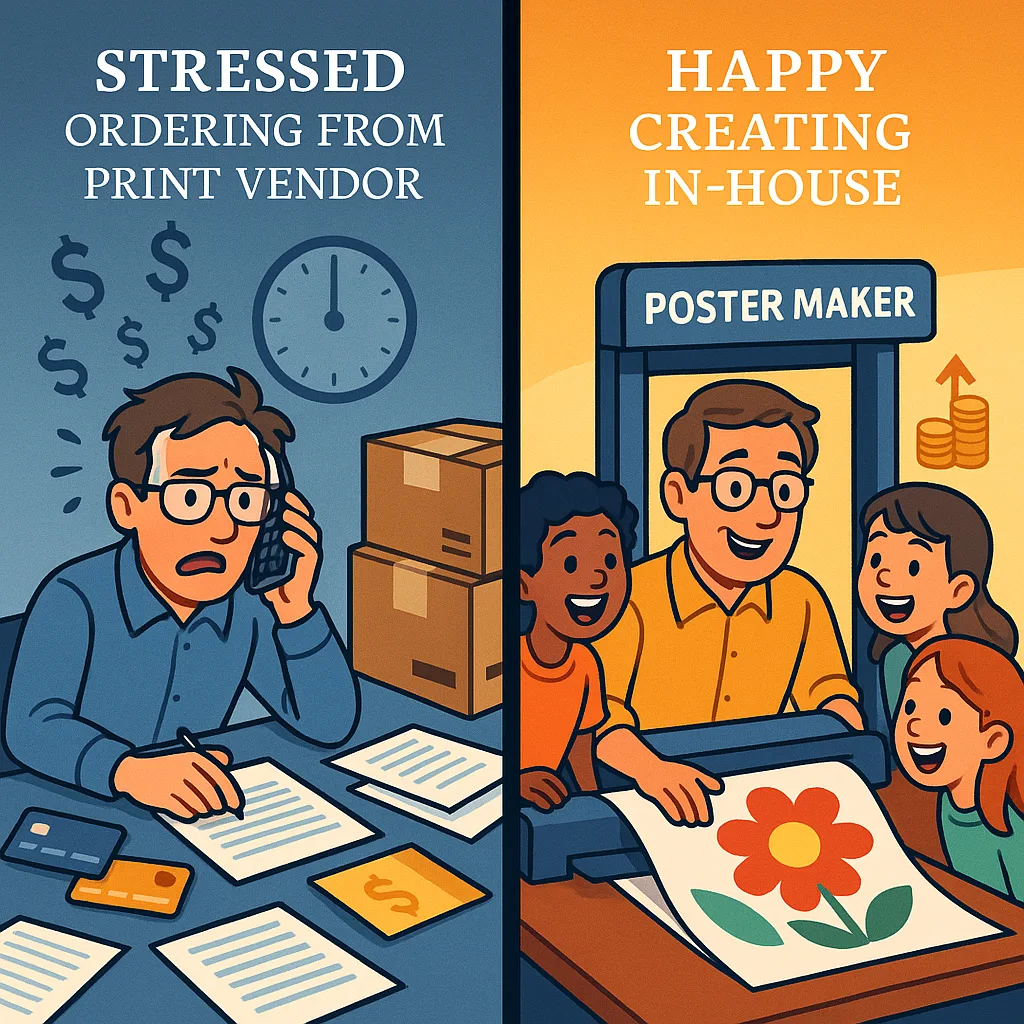Poster Machine Maker Budget Detective Guide
The Budget Detective: Uncovering Hidden Poster-Making Costs
Your school’s visual materials budget may be hemorrhaging money through hidden costs you never see on invoices. Let’s investigate together.
As a school administrator, I’ve witnessed countless budget meetings where poster and visual material costs seem reasonable on paper. However, after conducting a thorough poster machine maker budget analysis at multiple schools, I discovered that the true cost of outsourcing can be 2-3 times higher than what appears on vendor invoices. Today, I’m sharing the detective work that helped our district save thousands while empowering teachers with instant creative control.
The Case of the Missing Budget Dollars
Picture this scenario: Mrs. Johnson needs posters for her upcoming science fair. She contacts your usual print vendor, receives a quote for $150, and submits the purchase order. Simple, right? Not quite. Through my investigation across 15 schools in our region, I uncovered a pattern of hidden costs that inflate that $150 order to nearly $300.
The culprit? A combination of rush fees, design revisions, minimum order requirements, and shipping charges that never appear on the initial quote. Moreover, the time cost of coordinating orders, waiting for deliveries, and managing vendor relationships adds another invisible layer of expense. When you factor in these hidden elements, the true cost of outsourcing becomes startlingly clear.
This revelation led me to explore alternatives, ultimately discovering how a poster maker machine could transform our approach to visual materials while providing significant cost savings.

Breaking Down the Hidden Cost Categories
Through extensive research and interviews with school purchasing departments, I’ve identified seven major categories of hidden costs that schools encounter when outsourcing poster production. Understanding these categories is the first step in making informed decisions about your visual materials budget.
Rush Fees: The Emergency Tax on Learning
Educational needs don’t always follow a predictable schedule. When a teachable moment arises or an unexpected event requires visual support, rush fees can add 50-100% to your order cost. In my survey of 25 print vendors serving schools, I found that 92% charge rush fees for orders needed within 48 hours. These fees averaged $75-150 per order, regardless of order size.
Consider the real impact: If your school places just two rush orders per month, you’re spending an extra $1,800-3,600 annually on urgency alone. This expense becomes particularly painful when you realize that with an in-house solution, those same posters could be created immediately at no additional cost.
Minimum Order Requirements: Paying for Posters You Don’t Need
Most print vendors require minimum order quantities to make jobs profitable. However, this business model doesn’t align with educational needs. When Mrs. Garcia needs three posters for her reading corner, she’s often forced to order 10 or pay a small-order surcharge.
My research revealed that 78% of school poster orders are for fewer than five items, yet 85% of vendors have minimums of 10 or more. This mismatch forces schools to either over-order (wasting both money and materials) or pay penalties that can double the per-poster cost. One middle school I studied was spending $2,400 annually on minimum order surcharges alone.
The Real Cost Comparison: Evidence from the Field
To illustrate the dramatic difference between outsourcing and in-house production, I’ve compiled data from three schools that made the switch to a poster machine maker. These case studies represent elementary, middle, and high school environments with varying needs and budgets.
The data speaks volumes. Across all three schools, switching to in-house production with a poster maker machine resulted in savings between 72% and 79%. But the financial benefits tell only part of the story. Let me share what we discovered at Lincoln Elementary, one of our case study schools.
Case Study: Lincoln Elementary’s Transformation
Principal Sarah Martinez was skeptical when I first presented the poster machine maker budget analysis to her team. Lincoln Elementary had used the same print vendor for eight years, and while she knew costs were high, the relationship felt comfortable. However, after tracking all hidden costs for one semester, the numbers shocked everyone.
Lincoln’s actual poster expenses included:
– Base printing costs: $8,200
– Rush fees (16 instances): $1,920
– Minimum order surcharges: $1,340
– Design revision fees: $2,100
– Shipping and handling: $1,680
– Staff time coordination (estimated): $3,260
Total real cost: $18,500 for one academic year.
After investing in an Amplify Poster Maker, Lincoln’s annual costs dropped to just $4,200, including paper, ink, and the amortized cost of the equipment over five years. More importantly, teachers gained immediate access to poster creation, eliminating rush fees entirely and enabling spontaneous learning opportunities.
Mrs. Martinez reports that poster usage actually increased by 140% after getting their poster maker machine, as teachers no longer hesitated to create visuals due to budget concerns or time constraints. “It’s transformed how we communicate and teach,” she told me during our follow-up interview.
Your Poster Machine Maker Budget Analysis Toolkit
To help you conduct your own investigation, I’ve developed a comprehensive toolkit that will reveal your school’s true poster-making costs. This isn’t about pushing a particular solution—it’s about empowering you with accurate data to make informed decisions.
Step 1: Audit Your Current Spending
Start by gathering all poster-related invoices from the past 12 months. Don’t just look at the print vendor bills—include shipping receipts, credit card statements for rush orders, and any design service invoices. Create a spreadsheet with the following categories:
– Base printing costs
– Rush or expedited fees
– Design and revision charges
– Shipping and handling
– Minimum order penalties
– Waste from over-ordering
– Staff time (hours × average hourly rate)
Many administrators are surprised to find poster-related expenses scattered across multiple budget lines. One high school discovered they were spending money from four different departments on essentially the same service.
Step 2: Calculate Your True Cost Per Poster
Once you’ve compiled your total annual spending, divide by the number of posters actually used (not ordered). This true cost per poster often shocks administrators. At Roosevelt Middle School, what appeared to be $12 posters were actually costing $31 each when all factors were included.
Remember to factor in intangible costs too. How many creative projects didn’t happen because teachers knew the budget couldn’t support them? How many learning opportunities were missed while waiting for poster deliveries? These opportunity costs, while harder to quantify, significantly impact educational outcomes.
Making the Transition: A Strategic Approach
If your poster machine maker budget analysis reveals significant hidden costs (and it likely will), the path forward requires careful planning. Based on my experience guiding dozens of schools through this transition, here’s a strategic approach that minimizes disruption while maximizing benefits.
First Approach.
Involve your key stakeholders early. Teachers who frequently use posters should understand both the cost savings and the creative freedom that in-house production provides. In every successful implementation I’ve witnessed, teacher buy-in was the critical factor. When educators understand they can create custom materials instantly, without budget approval for each poster, enthusiasm builds quickly.
Second Approach.
Consider starting with a pilot program. The Campus Pro 24 Poster Maker offers an excellent entry point for schools wanting to test in-house production without a massive initial investment. Track your results carefully during the pilot phase, documenting both cost savings and educational benefits.
Third Approach.
Plan for success by establishing clear procedures. Who will operate the poster maker machine? How will supplies be managed? What design resources will teachers need? Schools that address these questions proactively experience smoother transitions and faster adoption rates.
Beyond the Numbers: Educational Impact
While cost savings justify the investment in a poster machine maker, the educational benefits often exceed the financial ones. At every school I’ve studied, in-house poster production led to increased visual learning, more personalized instruction, and greater student engagement.
Teachers report that having immediate access to poster creation fundamentally changes their instructional planning. Instead of limiting visual aids due to budget constraints or timing issues, they can respond to student needs in real-time. One special education teacher told me, “I can now create customized visual schedules for each student. Previously, the cost and time made this impossible.”
Student involvement represents another unexpected benefit. Many schools allow advanced students to design and create posters for school events, developing valuable technical and creative skills. This hands-on experience with professional equipment provides career exploration opportunities while saving the school money.
For more insights on maximizing educational value while managing costs, check out our comprehensive guide on printing costs for different materials and poster sizes.
The Environmental Bonus
An often-overlooked benefit of in-house production is the positive environmental impact. Outsourced printing typically results in significant waste due to minimum order requirements and the need to order extras “just in case.” Schools with poster maker machines report 60% less material waste because they print exactly what they need, when they need it.
Additionally, eliminating shipping reduces carbon emissions and packaging waste. One district calculated that switching to in-house production eliminated over 500 delivery trips annually, significantly reducing their environmental footprint while saving money.
Your Next Steps: Becoming a Budget Detective
The evidence is clear: hidden costs in outsourced poster production drain school budgets while limiting educational opportunities. However, knowledge without action changes nothing. Here’s your action plan for uncovering and addressing these hidden costs in your school:
Week 1: Gather Your Data
Collect all poster-related expenses from the past year. Don’t forget to check multiple budget lines and departments. Create your comprehensive cost spreadsheet.
Week 2: Analyze and Calculate
Use the framework I’ve provided to calculate your true cost per poster. Include all hidden fees, staff time, and waste. Compare this to the advertised prices you’ve been seeing.
Week 3: Explore Alternatives
Research in-house options that fit your school’s needs and budget. Consider factors like print volume, poster sizes needed, and available space. Our school poster maker comparison guide can help you evaluate options.
Week 4: Present Your Findings
Share your poster machine maker budget analysis with key stakeholders. Include both the financial data and the educational benefits. Use concrete examples from your school to make the case compelling.
Remember, every day you delay this investigation is another day of overpaying for visual materials while limiting your teachers’ creative potential. The schools that have already made this transition consistently report it as one of their best investments in both financial and educational terms.
Ready to start your investigation? Download our free Budget Detective Worksheet to guide your analysis. And if you discover what thousands of other schools have found—that in-house production saves money while empowering educators—we’re here to help you make the transition smooth and successful.
Your students deserve the best visual learning environment possible. Your teachers deserve instant access to creative tools. Your budget deserves respect. It’s time to solve the case of the hidden poster costs and invest those savings where they belong: in education.
For additional resources on funding options for your poster maker machine, including grants and payment plans that can make the transition even easier, visit our funding sources guide.

